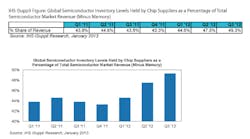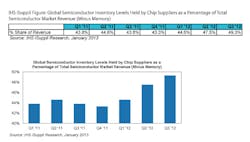Chip inventories among semiconductor manufacturers reached a worrisome high toward the end of 2012 and may signal tougher times for the electronics supply chain in 2013, according to a new report from industry analyst IHS iSuppli.
IHS’ recently released Semiconductor Inventory Insider Market Brief pointed to declining market conditions at the end of 2012, when overall semiconductor revenue fell 0.7% sequentially in the fourth quarter following high inventory increases in the third. Inventory levels in Q3 amounted to 49% of total semiconductor revenue according to iSuppli—the highest point since early in 2006.
Chip stockpiles among semiconductor suppliers had fallen during the final two quarters of 2011, but steadily ticked up after that, reaching 48 percent of total revenue in the second quarter before hitting the current peak in the third—the latest time for which full figures are available, IHS said.
The inventory level measured in its report refers to chip stockpiles in the hands of semiconductor suppliers, not to inventory throughout the electronics supply chain.
The report also pointed to weak consumer demand for new electronics as a key factor.
“The uncomfortably high level of inventory among semiconductor manufacturers of nearly all stripes is a result of key demand drivers failing to materialize,” said Sharon Stiefel, analyst for semiconductor market intelligence at IHS. “Demand for semiconductor devices has typically come from new products that consumers feel compelled to purchase. But going into the holiday season last year, no such new products marshaled enough impetus to overcome consumer fears about lingering economic woes. Two months prior to Christmas, consumer purchases of electronics had grown by only 0.7 percent, the worst performance since 2008.”
Poor performance in the PC sector was also a factor, as demand for tablet computers outstripped demand for mobile PCs, ultrabooks and similar products, the report said.
On the plus side, demand for feature-rich smart phones and tablets were expected to provide the strongest drive for semiconductors, with IHS pointing to an anticipated 4% rise in semiconductor revenue for the wireless segment at the end of 2012.
Looking ahead to this year, IHS and others say the outlook is still clouded by uncertain global economic conditions.
“The first quarter of 2013 likely will see growth in the industrial and automotive electronics segments. Other semiconductor markets, for their part, will overcome the seasonal decline normally expected at this time of year and then start to rebound around the second and third quarters,” according to IHS. “Such assumptions, however, rest on the even larger factor of the global economy, currently a volatile variable itself with no set outcome. If global economic forecasts perform according to positive expectations, semiconductor revenue could grow by 4 percent in the second quarter and by a very solid 9 percent in the third. However, if demand evaporates, semiconductor suppliers will find themselves in a deplorable oversupply situation, which would then lead to inventory write-downs throughout the year.”








